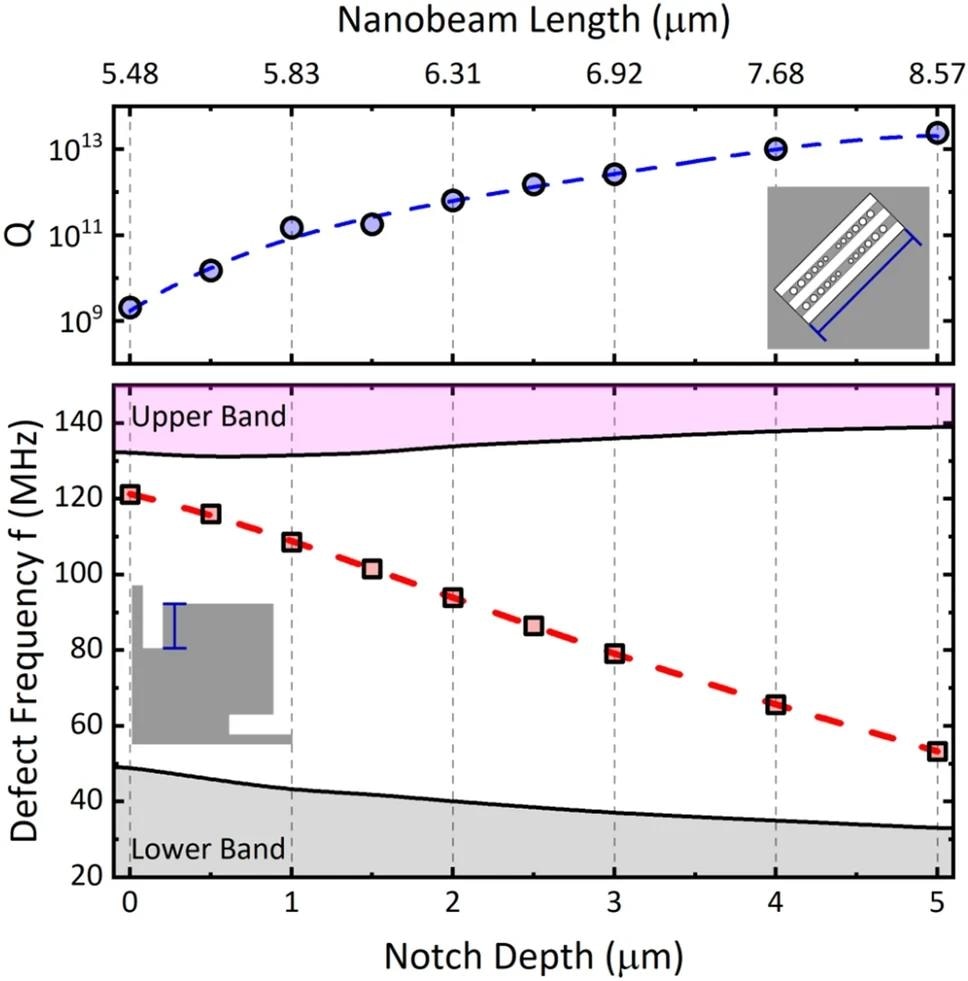In an article recently published in the journal Scientific Reports, researchers explored the novel concept of regenerative coupling in phononic crystals for room-temperature quantum optomechanics by applying the regenerative coupling technique to an optomechanically coupled nanobeam resonator.
 Evolution of the mechanical quality factor (upper chart) and Q-peak frequency (lower graph) within the phononic bandgap as a function of notch depth and nanobeam length. Note that the length of the nanobeam, which maximizes the quality factor depends on the notch depth (see Supporting Information for further details). Image Credit: https://www.nature.com/articles/s41598-024-63199-1
Evolution of the mechanical quality factor (upper chart) and Q-peak frequency (lower graph) within the phononic bandgap as a function of notch depth and nanobeam length. Note that the length of the nanobeam, which maximizes the quality factor depends on the notch depth (see Supporting Information for further details). Image Credit: https://www.nature.com/articles/s41598-024-63199-1
Quantum Advancement: Thermal Challenges
In recent years, quantum technologies have attained significant significance due to their crucial role in enabling transformative advancements in different fields, surpassing the capabilities of classical approaches, and empowering researchers to address complex challenges more effectively.
For example, quantum sensing, quantum metrology, and quantum computing provide unparalleled precision in imaging and sensing, along with significantly enhanced processing speeds. Coherence is a fundamental characteristic of quantum systems, and temperature is a crucial factor in maintaining this coherence.
Specifically, higher temperatures can disrupt quantum states by introducing thermal fluctuations, causing rapid degradation of quantum information. Thus, maintaining low temperatures that reduce thermal energy and the associated fluctuations is crucial to preserving coherence in quantum systems.
Precise manipulation of quantum states by preserving coherence is crucial for quantum computing, as low temperatures facilitate longer quantum gate operations and reduce computational errors. However, the requirement for ultra-low temperatures to maintain coherence restricts the application of quantum technologies in certain areas. Consequently, efforts to mitigate the effects of temperature and develop more robust quantum systems have become imperative. These advancements aim to make quantum technologies more accessible and practical across a wider range of fields.
The Proposed Approach
In this study, researchers introduced a novel method for phononic bandgap engineering using the finite element method (FEM). They aimed to reduce the radiative mechanical energy dissipation in a nanomechanical oscillator by coupling it with the complementary oscillating mode of a defect in a surrounding phononic crystal. This technique is designed to lessen the reliance on ultra-low temperatures to maintain coherence in quantum systems.
The focus was on achieving high values of the product f×Q, where Q represents the mechanical quality factor and f is the frequency of the mechanical mode. This was accomplished through the parametric amplification of the mechanical mode in an optomechanical double nanobeam resonator facilitated by regenerative coupling with a phononic defect mode.
The optomechanical resonator was constructed from coupled photonic crystal nanobeam cavities set within a two-dimensional phononic crystal membrane. This device was crafted from silicon, capitalizing on established fabrication methods for this material, which helped validate the concept of regenerative coupling.
In terms of design, the cavities in the free-standing silicon nanobeams—each 500 nm wide and 220 nm thick—featured nine holes with a linearly tapered arrangement, where the diameter and pitch of the holes progressively increased from 184 nm and 324 nm to 234 nm and 382 nm, respectively.
A fundamental TE-mode at λ = 1527 nm with a 3.5 × 104 optical quality factor was supported by the structure. A small mode volume of 0.02 λ3 and light could be coupled to the structure through vertical light injection. Moreover, the two nanobeams can interact through the optical force generated from overlapping their optical resonances.
Additionally, the interaction between the two nanobeams was not only mechanical but also optical, facilitated by the optical force emerging from the overlap of their optical resonances. The optomechanical coupling constant in this setup quantifies the strength of the interaction between the mechanical motion and the optical field inside the cavity, indicating how the cavity’s resonance frequency shifts in response to mechanical displacement.
Importance of this Work
The study showcased a powerful technique to significantly enhance the quality factor of a mechanical resonator by coupling it with a confined defect mode within a surrounding phononic shield through frequency matching. This method led to a marked reduction in radiative mechanical energy losses, allowing the f × Q products to surpass the threshold necessary for quantum measurements within the MHz frequency range, even at room temperature.
The implementation of this technique on an optomechanically coupled nanobeam resonator operating in the MHz regime resulted in the mechanical quality factor of the resonator increasing by up to four orders of magnitude compared to traditional phononic crystal designs. The device achieved f × Q products exceeding 1016 Hz with only two rows of phononic crystal shield.
Consequently, this allowed for the attainment of stable quantum states with mechanical decoherence times up to 700 µs at room temperature. Such advancements provide significant opportunities for enhancing mechanical resonator performance and propel forward the capabilities of room-temperature quantum technologies in various applications.
In summary, the findings from this study confirm the practicality of employing the regenerative coupling approach for room-temperature quantum optomechanics. The flexibility of this technique is notable, as it can be adapted to different types of resonators and frequency ranges, primarily through the geometrical optimization of the phononic crystal and the critical frequency matching between the resonator and the defect mode. This approach opens new avenues for advancing quantum mechanical systems without the stringent requirement for ultra-low operational temperatures.
Journal Reference
Weituschat, L. M., Castro, I., Colomar, I., Everly, C., Postigo, P. A., Ramos, D. (2024). Exploring regenerative coupling in phononic crystals for room temperature quantum optomechanics. Scientific Reports, 14(1), 1-9. https://doi.org/10.1038/s41598-024-63199-1, https://www.nature.com/articles/s41598-024-63199-1
Disclaimer: The views expressed here are those of the author expressed in their private capacity and do not necessarily represent the views of AZoM.com Limited T/A AZoNetwork the owner and operator of this website. This disclaimer forms part of the Terms and conditions of use of this website.